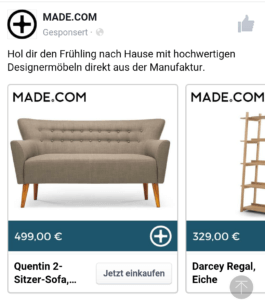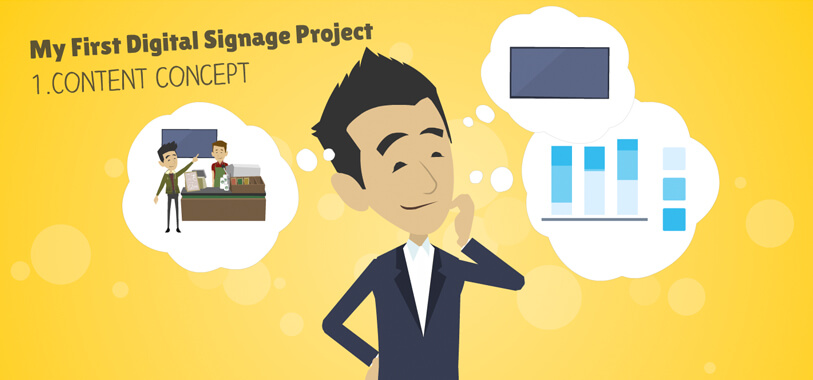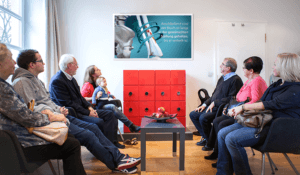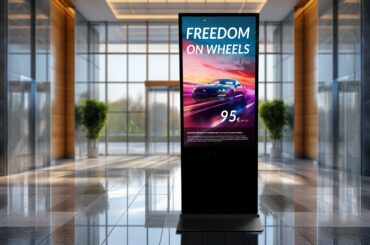“Digital Interactions influence 36 cents of every dollar spent in the retail store.” (retailtouchpoints.com)
Digital signage: Too good to be true?
Who would have thought that digitalization would grow this much, this fast? Almost a third of the money spent in stores can be traced back to digital interactions. But it doesn’t stop there:
76% of consumers enter a store because of the positive influence of digital signage. Their consumption increases by 30% thanks to the digital advertisement. And even brand recognition increases by around 48% because of digital signage. (DigitalSignangeToday.com)
76% of consumers enter a store because of the positive influence of digital signage.
These numbers speak for themselves, right?
Here’s the fly in the ointment:
Numbers are just that: numbers. Not every digital signage project is necessarily successful. The majority of projects don’t reach their full potential, despite what the numbers suggest. And here is why:
The right concept is missing.
“Technological innovations and a hyper-connected world have significantly influenced consumer behaviors and expectations. As a result, retailers are faced with a scary reality: change or become obsolete.” (Forbes.com)
Adapt or fail. Headline after headline is pushing retailers every day into one direction: Digitalization. And fast.
But how? This is the question every business without a “Digital Marketing Manager” asks themselves. The knowledge on how to meet the consumers’ digital needs are lacking, especially when it comes to how and where to install the technology.
Despite this, the race toward digitalization has started, pushed by customers’ growing expectations. To them, the internet has become a standard tool in which to utilize interactive technologies daily and purchase things online.
In a recent blog post, Forbes magazine explains consumer’s new expectations:
These days it is not enough to buy a digital signage screen, turn it on, and play an endless loop of digital advertisements.
This is exactly the problem. The understanding of where digital signage even begins is missing. Simply taking regular posters and putting them on LCD screens does not create comprehensive digital signage.
Straightforward product ads just disappear in the vast ocean of communications out there, not actually adding any value. And that is, what digital signage is supposed to do; isn’t it? So the first important rule is:
Create content that adds value.
There are no hard and fast rules of what a long-term content strategy is. The lines are pretty blurred.
Case Study: Digital Signage for real estate agents
Let’s look at a real estate agent for example. More and more real estate agents utilize large displays in their storefronts. I’d like to venture a guess and say that 90% of the content is pretty much the same all around: presenting digital listings. Printed copies of these offers would have the same effect – which brings us back to our point about added value.
Say you picked the perfect house for yourself, wouldn’t it be nice if you could then transfer all the information onto your smartphone by scanning a QR code? Or forward it on to your wife by tapping onto the interactive display.
Or even better: Send a contact form directly to the agent, if they are out with other customers. Additionally, you could also feature content that is directly addressing potential sellers or those, who could be in the near future.
By now you get the picture. Digital signage should be seen as an interactive, enriching communication tool, which can be utilized in any industry.
In order to really use the advantages digital signage has over static communications, here the second rule for your first digital signage project:
Plan your content before you purchase software and hardware. The three biggest challenges regarding the implementation of Digital Signage from the customers and advertisers view.
The graphic above shows that creating effective content strategies is difficult, especially when there is a lack of information on how to go about a targeted implementation.
Content strategy continues to be the focus of the three challenges, while less expensive POS compatible technology and media production continue to decrease the financial barriers.
But how do you go about the planning process? Where do you even get content? How do you cultivate it? Can you create your own content? If so, where?
There will be countless questions that will come up during the first steps. This guide aims to support you during your first digital signage project.
From content strategy to creating content, from choosing the right hardware to picking the right software, we will provide insights and also give you interesting facts, tips, and tools along the way.
Let’s get started.
The Content Concept: Setting goals
„Fifty-six percent of shoppers still think advertising is important to their purchase decision in-store.“ digitalsignagetoday.com
Would you have guessed that 56% of consumers still think in-store ads are an important factor in their purchase decisions? Of course this assumes that those in-store ads are done right. That’s why it is not surprising that digital signage is most often used for advertisements.
Increase in sales
If increasing sales is your goal, we want to show you three scenarios, where digital signage can be used effectively:
- Impulse purchases
- Cross-selling
- Up-selling
Why does digital signage work great here? The answer, including some cases, is below.
Impulse purchases
Studies have shown that 43% of consumers have a shopping list while shopping; or to say it differently: 57% of purchases happen without a structured list. (blog.promobitech.com)
This means that the importance of impulse purchases is not to be underestimated. Only 35% of all purchases are actually planned (this data is based on groceries). The other 65% have great potential to become impulse buys.
Do you really need digital signage for that? To answer that question, let’s look at what characteristics of products that are more likely to be purchased impulsively:
Low price and low involvement
The customer doesn’t think much about his purchase decision because these two characteristics suggest a low risk. All it takes is a short impulse that stirs the need for this type of product.
When it comes to impulse purchases, the inner voice sends only a short command: Buy
Through digital signage, customers can quickly take in relevant information, like promotions or discounts. Especially short videos or animations can grab their attention. Just remember when using videos, that digital signage is not like a regular TV commercial:
Depending on where your display is located, at the POS, in a hallway or a waiting room, your audience will only pay attention for two seconds before assessing the information as relevant or irrelevant.
Not using audio in most video projects makes it more difficult for your customers to grasp the content properly, so keep the following tip in mind:
Video concepts have to be understood easily in a very short amount of time.
Digital signage has three distinct characteristics that make it a more attractive option for impulse purchases compared to classic advertisements:
React quickly: Digital signage allows you to implement promotions quickly. Is it raining outside? Change your playlist and advertise umbrellas. The rain changed to snow? Display hats, scarves, and gloves on your digital advertising screen.
With digital signage, you can quickly react to changes in your inventory levels, expiration dates or even the weather forecast, all of which can help stimulate impulse purchases.
Changing content: 30% of consumers buy four or more goods than they had originally planned for. The problem: On a static poster you can only advertise one product for an impulse purchase.
Your digital advertising screen, however, lets you change your playlists anytime. Meaning you can change your content on the fly and advertise as many products as you like.
Save money: While hardware solutions are becoming more and more affordable, print costs are rising year after year.
If you look at the financials only, digital signage definitely wins the ROI race long-term. Media production is also becoming easier and cheaper, allowing especially smaller businesses to possibly save on agency expenses.
Around 33%: This number represents the increase in revenue that digital signage can generate; especially in regards to unplanned purchases. (embedsignage.com)
Before you start boosting your sales with digital signage, you should establish measurable goals.
Any goal should be precise, be it the “Muffin-to-go” in a café, mints at the check-out or costume jewelry in a boutique. Goals that leave room for discussion are badly worded and should be revisited.
It is important to work with precise measurements, values or numbers on which you can later use to base improvements on.
No: “We are advertising out “Muffin-to-go” and are increasing our revenue.”
Yes: “By advertising our “Muffin-to-go” Monday through Friday, 8 am to 12 pm, we want to sell 20% more muffins in the first month.”
The more detailed you are when you create your goals, the easier it is to determine what happened if you don’t meet them.
Were they just a little too ambitious? Did you advertise the muffins on the wrong days? Or could the timing of the playlist be optimized?
By precisely measuring your sales and revenue, you can keep an eye on when your digital signage investment pays off.
Cross-Selling
Direct one on one contact with customers is not always possible. There are times when the customer will have to navigate the store and try to search out the desired product on their own. That in itself is not a problem, we do it every day.
But the potential to alert them to additional, complementary products, can sometimes get lost in the shuffle. Once a customer is at the check-out, it is usually too late for cross-selling.
The real problem of cross-selling is this, though:
We don’t know the customer’s situation.
Let’s take a quick look at online shopping. Just yesterday I was looking for furniture online. A new couch to be specific. While I was looking through different shops, using their search functions and filters, I found a coach that I liked.
But I haven’t bought it yet. This morning, while looking through my Facebook timeline, there they were: “Sponsored” posts reminding me of the couch I had looked at yesterday. That’s pretty amazing, isn’t it?
 Offline has to learn from online.
Offline has to learn from online.
The internet knows what I want. It even suggested a shelving unit matching my new couch, that I now have in my living room. It doesn’t bother me that the advertisement was paid for because they fit my situation – they fit into the context.
And because the Internet is everywhere, the expectations of the online world have been transferred to the offline world. The fact that more than 90% of consumers use their smartphones while shopping, underlines this (marketingland.com).
What does bother me compared to these sponsored posts, are any kind of advertisements that are not of any interest to me (on TV, out-of-home or in a store). They simply don’t add value.
This is where digital signage comes in: You can control the content through precise customer profiles (don’t worry, we’ll get to that later!). Through digital cross-selling, you can promote
- Products outside of the product display
- Products that are difficult to display in-store
- Additional services
- Even online offers
Predictive targeting allows interesting cross-selling possibilities to become reality. Here is an example:
“Playlist 1: Cross-selling content for beer at the deli counter on a Friday night”
“Playlist 2: Recipe suggestions and images of vegetable at the deli counter on Tuesday around noon”
(Example based on “Digital Signage: Die globale Studie”)
Another interesting example in the above-mentioned global study was a case where shellfish sales were increased permanently, by using a combination of informative and promotional content.
Presenting a mix of recipe suggestions, nutritional facts and promotional offers, provided customers with added value and encouraged them to buy.
This is a great example for fulfilling cross-selling potential, while it also increased shellfish sales by 20%, nine months after the campaign ended.
Third party technology allows digital signage to take an even bigger step towards individualized content. Solutions like beacons, NFC, RFIDs, and IoT, can personalize messages almost as much as e-commerce can base on location tracking, movements, and precise data collection.
These technologies go beyond this blog post, but if you’re interested in more information, sign up for our newsletter.
Up-selling
The last scenario to increase sales is up-selling. I would like to mention that there are some similar components to cross-selling when implementing up-selling.
Instead of advertising our “blueberry muffin-to-go”, we would promote the slightly more expensive “chocolate muffin-to-go” on our digital menu. To put it more general: Promote products with higher margins.
This is especially interesting for businesses whose offerings change depending on the day or even the time of day, like bars, restaurants or cafés. The lunch menu can automatically change at 6 pm to the dinner menu, always showing the products with the highest margins.
Information Service
13% of the people who have service problems tell 20 others. Source: Understanding Customers, Ruby Newell-Legner
Everyone has had bad experiences. Worst case scenario they were in a store. Maybe because of inattentive service, missing product information or because of lacking directional signage in a big department store.
Sometimes that isn’t just annoying, it can actually be the reason customers stop coming to the store or stop buying a particular brand.
Isn’t it the brand’s job to make us feel comfortable and informed? To make all information readily available? This can also be called “cognitive-search process”.
This describes the effort a consumer has to find the item he or she needs to fulfill a perceived need.
For example, I am in a store, looking for a new smartphone and I’m a total beginner when it comes to technology. It’s Saturday afternoon and all the employees are busy with other customers.
There are 10 different smartphones in front of me, but which one is the right choice? The perceived cognitive search effort is increasing minute by minute and I decide to postpone my smartphone purchase. I can probably find more information online.
Stop: This is not how a customer experience should be. This is why digital signage is often confronted with providing relevant information with added value:
Provide informative content, that reduces the search effort.
Help customers navigate your store, create product and service transparency and build exceptional customer service.
Example Amazon:
A big success factor for the online giant Amazon are the customer reviews. Or have you ever had to choose between many great products and then picked the one without any customer reviews?
No, me either. Simply because I was missing the information on whether or not the product actually performs as advertised.
If we transfer this example to a regular store, there are many opportunities to build trust and decrease a customer’s search effort. And of course: sell more.
- Integrate online customer reviews in-store
- Interactive product overview solutions at POS
- Recipe ideas for certain groceries
- Information about where and how something was made
- Introduce your service team
- Create transparency; e.g. Which textiles were used?
- Play product videos: Does this drill performs as advertised?
- Information about inventory levels, to create a perceived shortage
- Promote the most popular product
- Showcase company information that can build trust with customers
- Storytelling through images
- Event information or directional signage
- …
Digital signage that shows informative information that also builds trust, will get more attention that displays that only show promotional content.
This gives you the chance to build a balanced playlist with an optimal mix of information and advertisement. Keep in mind the following tip:
Present information relevant to the company and the products.
Digital signage is often used to display the weather, the news or celebrity gossip. The advantage here is that you don’t have to create your own content because this kind of information is provided by third parties.
But are the weather forecast and the news really relevant to your customers?
The answer is: It depends on the location of the displays, of course, the industry you are in and the context in which the content is being displayed.
Offers like the Wartezimmer-TV, a german digital signage content provider, is specialized in providing patients information in a modern way while they are waiting.
Information related to healthcare and the doctor’s office are a welcome distraction for patients within this context. The content is relevant to the patients’ and builds trust in the healthcare providers while helping to decrease the perceived waiting time. A win-win situation.
The weather forecast has little relevance to customers in a store. Most customers will simply ignore it, or it could even distract them from their original purchase decision.
That’s why we suggest that the focus should be on product or business related information, especially in retail.
Entertainment
The other day I was looking for a restaurant with colleagues, when we saw a digital signage solution in a well-known burger place in Düsseldorf, that really grabbed our attention:
They were showing a live stream of their Instagram account. Guests were encouraged to take pictures of their delicious burger and post them on Instagram with a special hashtag.
Those pictures were now showing up on the screen in the restaurant’s window!
The result: An unbelievable presence on Instagram, which is based on the fact that consumers increasingly love to share everything. Social networks, blogs or customer review portals – consumers love to give their opinions.
So far over 8,400 Instagram posts about these delicious burgers were created by guests. Incredible!
 More about social media integration in restaurants here.
More about social media integration in restaurants here.
Yes, we also took pictures of the crispy fries and the juicy burger. Why? Because I like sharing events and experiences. It doesn’t matter if I purchase new sneakers, go to a restaurant or to the movies.
As soon as I consume something, I want to share this experience. I’m staying connected to my friends this way. They know what I like and this also means your brand is on their radar.
I believe that this is the reason that the entertainment factor of digital signage needs to grow in importance. It doesn’t directly aim to increase sales, but the right kind of entertainment provides me with a great experience, making me more brand loyal.
In times like these, where consumers have more and more power, brand loyalty is more important than ever:
Three out of four millennials would rather pay for an experience than a product.
When it comes to the consumer experience, interactive digital signage installations are an excellent way to include a customer into the business processes.
This can be achieved by showing social media channels, but also through interactive shopping solutions, virtual mirrors, NFCs or Beacons.
But entertainment can also be conveyed through emotional, expressive images or videos. The main focus should be the quality of the product presentation.
Nike is an exceptional example of how digital signage can communicate brand messages in a pleasing way.
To the Point
Digital signage, among other things, is also a great tool to achieve long-term goals like customer retention and customer satisfaction. A mix of promotion, information, and entertainment is a good recipe for success.
The key to success is a well thought out content strategy, which should be continuously adapted and expanded, always optimizing the content based on the day of the week and time of the day. This is the best way to provide relevant information to customers.
In addition, it is important to learn from the advantages of online marketing, where customers always get the information they need during their purchasing process.
Digital signage is able to provide increasingly personalized content because of its own multimedia capabilities or by utilizing third party technology.
Entertainment, like interactive content, is playing a growing role in this context. We want to share everything, expect that technology delivers without problems and first and foremost, that retail provides us as consumers a change of routine.
Simply stated:
A mix of promotion, information, and entertainment is a good recipe for success.








